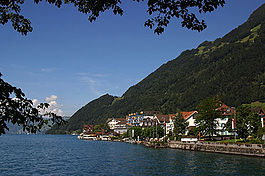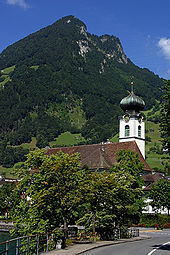Gersau
Gersau | |
|---|---|
 | |
| Coordinates:46°59′N8°31′E/ 46.983°N 8.517°E | |
| Country | Switzerland |
| Canton | Schwyz |
| District | Gersau |
| Area | |
| • Total | 23.70 km2(9.15 sq mi) |
| Elevation | 435 m (1,427 ft) |
| Population | |
| • Total | 2,319 |
| • Density | 98/km2(250/sq mi) |
| Time zone | UTC+01:00(Central European Time) |
| • Summer (DST) | UTC+02:00(Central European Summer Time) |
| Postal code(s) | 6442 |
| SFOS number | 1311 |
| ISO 3166 code | CH-SZ |
| Surrounded by | Arth,Beckenried(NW),Buochs(NW),Emmetten(NW),Ennetbürgen(NW),Ingenbohl,Lauerz,Vitznau(LU) |
| Website | www SFSO statistics |
Free State and Republic of Gersau Freistaat und Republik Gersau | |||||||||||||
|---|---|---|---|---|---|---|---|---|---|---|---|---|---|
| 1433–1798 1814–1818 | |||||||||||||
| Status | City-republic and analliedprotectorate of theOld Swiss Confederacy | ||||||||||||
| Capital | Gersau | ||||||||||||
| Government | Republic | ||||||||||||
| Historical era | Early Modern Age | ||||||||||||
• Purchased liberty from theCounts of Habsburg | 1390 | ||||||||||||
• GainedReichsfreiheit | 1433 | ||||||||||||
• Annexed toHelv. Rep. | 1798 | ||||||||||||
| February 19, 1803 | |||||||||||||
• Regained independence | 1814 | ||||||||||||
• Annexed by Switzerland | 1818 | ||||||||||||
| |||||||||||||
Gersauis amunicipalityanddistrictin thecanton of Schwyzin Switzerland, sitting on the shores ofLake Lucerne.Gersau was for many centuries an independentmicro-statein permanent alliance with the Swiss Confederation.
History
[edit]
Gersau is first mentioned in 1064 asGersouwe.[4]The estates of Gersau gradually came into the hands of theHabsburgs,but in 1333, under dukesAlbert IIandOtto IVthe Merryof Austria, the jurisdiction and rights over Gersau fell into the hands of Lucerne nobility. On 1359, Gersau allied with theOld Swiss Confederacyas aprotectorateof the Confederacy, for its protection and to gain arms from the confederates. On 9 July 1386, the citizens of Gersau fought with the Swiss for the first time, on thebattlefield of Sempach,where the banner of Count Rudolf of Hohenzollern was captured.
Republic of Gersau
The Republic of Gersau (called "altfrye Republik Gersau", literal "old-free Republik Gersau", in early modern times) was an independent small state in the area of today's Canton of Schwyz in Switzerland. It was created in 1390 when the residents of the village of Gersau bought themselves free from the rule by bailiffs from Lucerne and from then on exercised their rights themselves. In 1433 they were officially granted the status of a direct imperial free state in the Holy Roman Empire by Emperor Sigismund. After that, Gersau took care of its internal affairs for over three and a half centuries. Within the Confederation, the republic was a place that turned towards it and was under the protection and patronage of the four forest sites (Luzern, Schwyz, Uri and Unterwalden).
With the French invasion of 1798, the republic fell and was assigned to the canton of Waldstätten during the time of the Helvetic Republic. The mediation constitution decreed by Napoleon Bonaparte attached the village to the canton of Schwyz. After the end of Napoleon's rule, the inhabitants again proclaimed the Republic of Gersau in 1814, which was recognized by the old umbrella towns. Based on the provisions of the Congress of Vienna and the Federal Treaty of 1815, the canton of Schwyz strove to incorporate the 23.7 square kilometer republic located between the southern slope of the Rigi and the northern shore of Lake Lucerne. This was achieved in 1817 with the approval of the Diet. On January 1, 1818, the republic was dissolved; their area today forms the Gersau district.
Gersau purchased its liberty from the counts of Habsburg in 1390 for the sum of 690Pfundsinpfennigs.The fate of theVogteiand whether or not the municipality pledged to the Confederacy was then in the hands ofLucernersJohn, Peter and Agnes von Moos; as a result, the jurisdiction,Vogteiand tax rights went to the courtiers of Gersau, allowing a free municipality without being mortgaged to some other power. InBasel,in 1433, Gersau received original confirmation of the ancient freedoms, rights and privileges fromEmperor Sigismund,thus becoming aReichsunmittelbarmunicipality under the direct protection of theHoly Roman Emperor,with its own courts, covering an area of 24 km2(9.3 sq mi).
During theFrench Revolutionary WarsGersau was annexed into theHelvetic Republic,becoming a district of thecanton of Waldstätten.After theAct of Mediationand the collapse of the Helvetic Republic, Gersau became a district of the canton of Schwyz until 1814, when it regained its independence, with Schwyzer approval, centred on the 1745Rathaus,containing council chambers and a courtroom (now a museum).
In 1817, theTagsatzungdecided, on the basis of theCongress of Viennaand the first article of theFederal Treatythat Gersau should be united with the canton of Schwyz, which took effect the following year, against its wishes, becoming the sixth and last district of the canton of Schwyz.
Geography
[edit]Gersau is in a self-contained location, nestled in a sunny recess in the lee of the south face ofRigi.Gersau is protected from cool winds by theRigi-Hochfluh and Gersauerstock peaks to the north, and the winds are further moderated by Lake Lucerne to the south. This produces a mild climate in whichSweet Chestnuttrees thrive, and as a result of which Gersau is known in the region as theRiviera of Lake Lucerne.
Gersau has an area, as of 2006[update],of 14.4 km2(5.6 sq mi). Of this area, 40.3% is used for agricultural purposes, while 52.4% is forested. Of the rest of the land, 5.7% is settled (buildings or roads) and the remainder (1.7%) is non-productive (rivers, glaciers or mountains).[5]
Until the mid 19th Century Gersau could only be reached by water or over the Gätterli pass fromLauerz.Since 1817 it has been the only municipality in the District of Gersau.
TheBeckenried–Gersau car ferrylinks Gersau withBeckenried,on the opposite bank ofLake Lucerne.
Demographics
[edit]| year | population[4] |
|---|---|
| 1774 | ca. 1,000 |
| 1850 | 1,585 |
| 1870 | 2,270 |
| 1880 | 1,775[a] |
| 1900 | 1,887 |
| 1910 | 2,263[b] |
| 1950 | 1,890 |
| 1960 | 1,754 |
| 1970 | 1,753 |
| 1980 | 1,813 |
| 1985 | 1,801 |
| 1990 | 1,851 |
| 2000 | 1,965 |
| 2005 | 1,972 |
| 2007 | 1,970 |
Gersau has a population (as of 31 December 2020) of 2,364.[6]As of 2007[update],17.7% of the population was made up of foreign nationals.[7]Over the last 10 years the population has decreased at a rate of −0.1%. Most of the population (as of 2000[update]) speaks German (90.6%), with Serbo-Croatian being second most common ( 2.0%) and Italian being third ( 1.7%).[5]
As of 2000[update]the gender distribution of the population was 50.5% male and 49.5% female. The age distribution, as of 2008[update],in Gersau is; 464 people or 24.0% of the population is between 0 and 19. 481 people or 24.9% are 20 to 39, and 657 people or 34.0% are 40 to 64. The senior population distribution is 180 people or 9.3% are 65 to 74. There are 105 people or 5.4% who are 70 to 79 and 47 people or 2.43% of the population who are over 80.[7]
As of 2000[update]there are 799 households, of which 258 households (or about 32.3%) contain only a single individual. 41 or about 5.1% are large households, with at least five members.[7]
In the 2007 election the most popular party was theSVPwhich received 39.5% of the vote. The next three most popular parties were theCVP(28.9%), theFDP(14.9%) and theSPS(12.5%).[5]
The entire Swiss population is generally well educated. In Gersau about 66.8% of the population (between age 25–64) have completed either non-mandatoryupper secondary educationor additional higher education (either university or aFachhochschule).[5]
From the 2000 census[update],1,494 or 77.2% areRoman Catholic,while 132 or 6.8% belonged to theSwiss Reformed Church.Of the rest of the population, there are 69 individuals (or about 3.57% of the population) who belong to the Orthodox Church, and there are less than 5 individuals who belong to another Christian church. There are less than 5 individuals who are Jewish, and 60 (or about 3.10% of the population) who areIslamic.There are 18 individuals (or about 0.93% of the population) who belong to another church (not listed on the census), 90 (or about 4.65% of the population) belong to no church, are agnostic oratheist,and 67 individuals (or about 3.46% of the population) did not answer the question.[7]
Heritage sites of national significance
[edit]
TheParish Churchof St. Marzellus is listed as a Swissheritage site of national significance.The entire village of Gersau is part of theInventory of Swiss Heritage Sites.[8]
Economy
[edit]Historically, silkweavingandwoodworkingwere the predominant industries. Today, however, tourism has become the main economic sector. Gersau has been a well-knownhealthand vacationresortsince 1860, with a significant number of hotels andguest houses.
Gersau has an unemployment rate of 1.62%. As of 2005[update],there were 105 people employed in theprimary economic sectorand about 43 businesses involved in this sector. 129 people are employed in thesecondary sectorand there are 25 businesses in this sector. 350 people are employed in thetertiary sector,with 71 businesses in this sector.[5]
Cuisine
[edit]Culinary specialties of Gersau include saltycheesecakeand a dessert calledRahmschinken.
Famous people
[edit]Born in Gersau
[edit]- Walter Nigg (1903–1988), Theologian
- Josef Maria Camenzind (1904–1984),Catholicpriest and writer
- Benno Ammann (1904–1986), conductor and composer
- Oskar Camenzind(1971– ), former professionalroad racing cyclist,1998 road cycling world champion
Notes
[edit]References
[edit]- ^ab"Arealstatistik Standard - Gemeinden nach 4 Hauptbereichen".Federal Statistical Office.RetrievedJanuary 13,2019.
- ^"Ständige Wohnbevölkerung nach Staatsangehörigkeitskategorie Geschlecht und Gemeinde; Provisorische Jahresergebnisse; 2018".Federal Statistical Office. April 9, 2019.RetrievedApril 11,2019.
- ^http://www.gersau.ch/de/bezirk-gersau/portraet/portraet.html.
{{cite web}}:Missing or empty|title=(help) - ^abGersauinGerman,FrenchandItalianin the onlineHistorical Dictionary of Switzerland.
- ^abcdeSwiss Federal Statistical OfficeArchivedJanuary 5, 2016, at theWayback Machineaccessed August 31, 2009
- ^"Ständige und nichtständige Wohnbevölkerung nach institutionellen Gliederungen, Geburtsort und Staatsangehörigkeit".bfs.admin.ch(in German). Swiss Federal Statistical Office - STAT-TAB. December 31, 2020.RetrievedSeptember 21,2021.
- ^abcdCanton Schwyz StatisticsArchivedJune 9, 2011, at theWayback Machine(in German)accessed August 27, 2009
- ^"Kantonsliste A-Objekte".KGS Inventar(in German). Federal Office of Civil Protection. 2009. Archived fromthe originalon June 28, 2010.RetrievedApril 25,2011.
Further reading
[edit]Jackson, Thomas (1873)."The Smallest Republic in the World".The Quiver.viii.Cassell, Petter & Galpin:685–686.RetrievedJuly 15,2011.
External links
[edit]- GersauinGerman,FrenchandItalianin the onlineHistorical Dictionary of Switzerland.
- States and territories established in 1433
- Municipalities of the canton of Schwyz
- Districts of the canton of Schwyz
- Former protectorates of Switzerland
- 1798 disestablishments
- 1814 establishments in Switzerland
- Populated places on Lake Lucerne
- Cultural property of national significance in the canton of Schwyz
- Former republics in Europe





